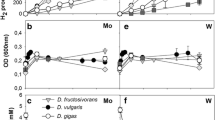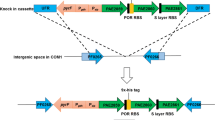Abstract.
Washed cells of Desulfovibrio vulgaris strain Marburg (DSM 2119) reduced oxygen to water with H2 as electron donor at a mean rate of 253 nmol O2 min–1 (mg protein)–1. After separating the periplasm from the cells, more than 60% of the cytochrome c activity and 90% of the oxygen-reducing activity were found in the periplasmic fraction. Oxygen reduction and the reduction of cytochrome c with H2 were inhibited by CuCl2. After further separation of the periplasm by ultrafiltration (exclusion sizes 30, 50, and 100 kDa), oxygen reduction with H2 occurred with the retentates only. Ascorbate plus tetramethyl-p-phenylenediamine (TMPD), however, were also oxidized by the filtrates. The stoichiometry of 1 mol O2 reduced per 2 mol ascorbate oxidized indicated the formation of water. Our experiments present evidence that in D. vulgaris periplasmic hydrogenase and cytochrome c play a major role in oxygen reduction. Preliminary studies with other Desulfovibrio species indicated a similar function of periplasmic c-type cytochromes in D. desulfuricans CSN and D. termitidis KH1.
Similar content being viewed by others
Author information
Authors and Affiliations
Additional information
Electronic Publication
Rights and permissions
About this article
Cite this article
Baumgarten, A., Redenius, I., Kranczoch, J. et al. Periplasmic oxygen reduction by Desulfovibrio species. Arch Microbiol 176, 306–309 (2001). https://doi.org/10.1007/s002030100329
Received:
Revised:
Accepted:
Issue Date:
DOI: https://doi.org/10.1007/s002030100329




